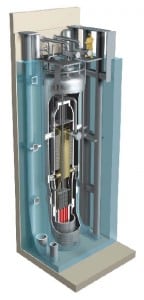NuScale Poised to Submit Nation's First-Ever SMR Design Certification Application to NRC
NuScale will submit the nation’s first application for design certification of a small modular reactor (SMR) to the Nuclear Regulatory Commission (NRC) on Thursday.
The Corvallis, Ore.–based company, which is majority owned by the Fluor Corp., has been developing its light-water reactor nuclear technology for more than 15 years. Development of the NuScale power module has been watched intently because it can be factory made and transported to generation sites via rail, truck, or barge. It also eliminates the need for safety-related electrically driven motors and valves necessary to protect the core. It instead uses convection, conduction, and gravity to drive the flow of coolant in the reactor.
A modular technology. NuScale is an integral pressurized-water reactor designed by NuScale Power, based on the Multi-Application Small Light Water Reactor developed at Oregon State University in the early 2000s. NuScale is a 65-foot-tall, 9-foot-diameter natural circulation light water reactor with the reactor core and helical coil steam generator located in a common reactor vessel in a cylindrical steel containment. The reactor vessel/containment module is submerged in water in the reactor building’s safety-related pool. The reactor building, designed to hold 12 modules (each 50 MWe and 160 MWt), is located below grade. Courtesy: NuScale
An SMR Darling
The technology has several backers. The Department of Energy (DOE) in December 2013 selected NuScale as the sole awardee for funding in the second round of the agency’s small modular reactor licensing technical support program. Consequently, NuScale may receive up to $217 million of matching funds over five years to support licensing expenses.
The company said that the funding enabled it to expand its workforce to include more than 600 people—and propelled progress on engineering, analysis, and testing needed to complete the design certification application.
However, NuScale will still need timely completion of the design certification and combined operating licensing efforts by the NRC in order to meet customer needs. John Hopkins, NuScale Power chairman and CEO, told lawmakers at the U.S. Senate Committee on Energy and Natural Resources in May 2016 that regulatory uncertainties and skepticism that the NRC can complete its review within planned timeframes are “two consistent concerns” voiced by prospective customers and investors.
NuScale wants commercial operation of the SMR to begin in 2024, Hopkins said. The company has engaged with the NRC on pre-application review efforts for the technology since April 2008. After NuScale submits its application on January 12, the NRC plan for design certification review spans about 40 months. To help the NRC stay on track, the company submitted portions of its application—topical reports on 13 specific aspects of design—early, Hopkins said.
Meanwhile, the company has been preparing for its first deployment project with the Utah Associated Municipal Power Systems (UAMPS) in Idaho, possibly at a location on the DOE’s Idaho National Laboratory site. That project could comprise 12 power modules to generate a total of 600 MWe. It has been estimated to cost about $3 billion.
Energy Northwest, a company that operates the 1,190-MW Columbia Generating Station near Richland, Wash., has joined the project and reportedly holds a “first right of offer” to operate the UAMPS project.
Other SMRs in the Queue
According to the NRC, NuScale’s design certification application will be the first it has received for an SMR. However, the regulatory body said it has engaged in varying degrees of pre-application activities with “several” SMR designers over the past several years.
Beyond NuScale, the NRC has engaged with BWX Technologies (BWXT) for its mPower design since July 2009. On April 15, 2013, the DOE and mPower signed a cooperative agreement for funding to support development and licensing of mPower. After recent difficulties, the third-generation SMR got a boost in March 2016 when engineering and construction firm Bechtel announced a new agreement with BWXT to pursue accelerated development of a project known as “Generation mPower.” The project involves development of a 195-MW power plant using mPower technology.
The NRC said it has also held “limited pre-application interactions” to discuss SMR issues related to Holtec International’s SMR-160 to support long-term licensing.
In another first, the NRC received the only early site permit application to date for an SMR in May 2016. The Tennessee Valley Authority (TVA) submitted the ESP application for a potential future SMR plant at its Clinch River site, 25 miles northwest of Knoxville in eastern Tennessee. The pioneering move could result in an operating plant at the site by 2026 if the TVA chooses to pursue development.
For more on SMRs, see: “Is There a Market for Small Modular Reactors?” in POWER’s June 2016 issue.
—Sonal Patel, associate editor (@POWERmagazine, @sonalcpatel)
